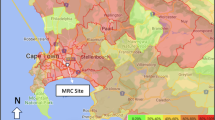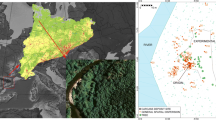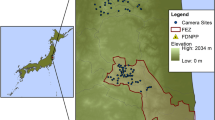Abstract
Scavenging animals often scatter skeletal remains of forensic interest and cause scavenging damage. This study aimed to identify scavenging animals in the peri-urban agricultural Highveld of South Africa, describe their scattering patterns, and the damage they cause to bone. Ten pig carcasses (Sus scrofa domesticus) (40–80 kg) were placed at the University of Pretoria’s Mierjie Le Roux Experimental Farm (Highveld) in summer and winter. Motion-activated cameras recorded the scavenging. Scavenger species were identified and their behaviors, scattering pattern, and the damage they cause to bone were described. Scavenging was primarily by black-backed jackals; however, mongooses (slender, yellow, and water mongoose), Cape porcupine, and honey badger were also active. Remains were commonly scattered in two directions by jackals. The distance of scattering was heavily influenced by fencing. The remains were scattered within a maximum radius of 73.7 m. The remains were scavenged and skeletonized faster in summer. Jackals caused minimal damage to bone, isolated to superficial, nonspecific scores, furrows, and punctures. A few mongoose bone alterations were present as jagged gnaw marks on the angle of the mandible and gnawing of the vertebral spinous process. Cape porcupine bone damage included gnaw marks on the condyle of a femur and head of humerus, and destruction of the proximal and distal ends of a tibia. The described scattering pattern and bone modification patterns will assist in the recovery and analysis of scavenged remains found in peri-urban agricultural areas in South Africa.





Similar content being viewed by others
References
Spies MJ, Gibbon VE, Finaughty DA (2018) Forensic taphonomy: vertebrate scavenging in the temperate southwestern cape, South Africa. Forensic Sci Int 290:62–69
O'Brien RC, Forbes SL, Meyer J, Dadour I (2010) Forensically significant scavenging guilds in the southwest of Western Australia. Forensic Sci Int 198(1–3):85–91
O'Brien RC, Appleton AJ, Forbes SL (2017) Comparison of taphonomic progression due to the necrophagic activity of geographically disparate scavenging guilds. Can Soc Forensic Sci J 50(1):42–53
Spies MJ, Finaughty DA, Gibbon VE (2018) Forensic taphonomy: scavenger-induced scattering patterns in the temperate southwestern cape, South Africa—a first look. Forensic Sci Int 290:29–35
Abay GY, Bauer H, Gebrihiwot K, Deckers J (2011) Peri-urban spotted hyena (Crocuta crocuta) in northern Ethiopia: diet, economic impact, and abundance. Eur J Wildl Res 57(4):759–765
Schuette P, Creel S, Christianson D (2013) Coexistence of African lions, livestock, and people in a landscape with variable human land use and seasonal movements. Biol Conserv 157:148–154
StatsSA (2019) Governance, public safety and justice survey GPSJS 2018/19. Pretoria, South Africa
Brits DM, Steyn M, Hansmeyer C (2020) Identifying the unknown and the undocumented: the Johannesburg (South Africa) experience. In: Parra RC, Zapico SC, Ubelaker DH (eds) Forensic science and humanitarian action: interacting with the dead and the living, vol 17. John Wiley & Sons, pp 681–692
Young A, Stillman R, Smith MJ, Korstjens AH (2014) Scavenging in Northwestern Europe: a survey of UK police specialist search officers. Policing 8(2):156–164
Young A, Stillman R, Smith MJ, Korstjens AH (2016) Applying knowledge of species-typical scavenging behavior to the search and recovery of mammalian skeletal remains. J Forensic Sci 61(2):458–466
Reeves NM (2009) Taphonomic effects of vulture scavenging. J Forensic Sci 54(3):523–528
Keyes CA, Myburgh J, Brits D (2020) Taphonomic bone trauma caused by Southern African scavengers. Int J Legal Med 134:1227–1238
Young A, Stillman R, Smith MJ, Korstjens AH (2014) An experimental study of vertebrate scavenging behavior in a Northwest European woodland context. J Forensic Sci 59(5):1333–1342
Young A, Stillman R, Smith MJ, Korstjens AH (2015) Scavenger species-typical alteration to bone: using bite mark dimensions to identify scavengers. J Forensic Sci 60(6):1426–1235
Rothschild MA, Schneider V (1997) On the temporal onset of postmortem animal scavenging:“motivation” of the animal. Forensic Sci Int 89(1–2):57–64
Morton RJ, Lord WD (2006) Taphonomy of child-sized remains: a study of scattering and scavenging in Virginia, USA. J Forensic Sci 51(3):475–479
Inger R, Cox DT, Per E, Norton BA, Gaston KJ (2016) Ecological role of vertebrate scavengers in urban ecosystems in the UK. Ecol Evol 6(19):7015–7023
Huijbers CM, Schlacher TA, Schoeman DS, Weston MA, Connolly RM (2013) Urbanisation alters processing of marine carrion on sandy beaches. Landsc Urban Plan 119:1–8
Spies MJ, Finaughty DA, Friedling LJ, Gibbon VE (2020) The effect of clothing on decomposition and vertebrate scavengers in cooler months of the temperate southwestern Cape, South Africa. Forensic Sci Int 309:110197
Matuszewski S, Hall MJ, Moreau G, Schoenly KG, Tarone AM, Villet MH (2019) Pigs vs people: the use of pigs as analogues for humans in forensic entomology and taphonomy research. Int J Legal Med 134:793–810
Myburgh L, L’Abbe EN, Steyn M, Becker PJ (2013) Estimating the postmortem interval (PMI) using accumulated degree-days (ADD) in a temperate region of South Africa. Forensic Sci Int 229(1–3):165e1–165e6
Keough N, Myburgh J, Steyn M (2016) Scoring of decomposition: a proposed amendment to the method when using a pig model for human studies. J Forensic Sci 62(4):986–993
Stuart C, Stuart M (2017) Stuarts’ field guide to the larger mammals of Africa, 4th edn. Struik Nature, Century City
Reynolds C (2015) Sasol 300 easy-to-see Birds in Southern Africa. Penguin Random House, South Africa
Michaud JP, Moreau G (2011) A statistical approach based on accumulated degree-days to predict decomposition-related processes in forensic studies. J Forensic Sci 56(1):229–232
Galloway A, Birkby WH, Jones AM, Henry TE, Parks BO (1989) Decay rates of human remains in an arid environment. J Forensic Sci 34(3):607–616
Binford LR (2014) Bones: ancient men and modern myths. Academic press, New York.
Haynes G (1983) A guide for differentiating mammalian carnivore taxa responsible for gnaw damage to herbivore limb bones. Paleobiology 9(2):164–172
Selvaggio MM, Wilder J (2001) Identifying the involvement of multiple carnivore taxa with archaeological bone assemblages. J Archaeol Sci 28(5):465–470
Brain CK (1983) The hunters or the hunted?: an introduction to African cave taphonomy. University of Chicago Press, Chicago.
Andrés M, Gidna AO, Yravedra J, Domínguez-Rodrigo M (2012) A study of dimensional differences of tooth marks (pits and scores) on bones modified by small and large carnivores. Archaeol Anthropol Sci 4(3):209–219
Duthie A, Skinner J (1986) Osteophagia in the cape porcupine Hystrix africaeaustralis. S Afr J Zool 21(4):316–318
Rabinovitch R, Horwitz LK (1994) An experimental approach to the study of porcupine damage to bones: a gnawing issue. Artefacts 9:97–118
Peterhans JK (1990) The roles of porcupines, leopards and hyenas in ungulate carcass dispersal: implications for paleoanthropology. Dissertation, University of Chicago.
Kaunda SKK (2010) Black backed jackal (Canis mesomelas) predation on impala (Aepyceros melampus) at Mokolodi nature reserve Botswana. Dissertation, University of Pretoria
Van de Ven TM, Tambling CJ, Kerley GI (2013) Seasonal diet of black-backed jackal in the Eastern Karoo, South Africa. J Arid Environ 99:23–27
Jenner N, Groombridge J, Funk S (2011) Commuting, territoriality and variation in group and territory size in a black-backed jackal population reliant on a clumped, abundant food resource in Namibia. J Zool 284(4):231–238
Hiscocks M (1987) Feeding observations and diet of black-backed jackals in an arid coastal environment. S Afr J Wildl Res 17(2):55–58
Avery G, Avery D, Braine S, Loutit R (1987) Prey of coastal black-backed jackal Canis mesomelas (Mammalia: Canidae) in the Skeleton Coast Park, Namibia. J Zool 213(1):81–94
Rowe-Rowe D (1983) Black-backed jackal diet in relation to food availability in the Natal Drakensberg. S Afr J Wildl Res 13(1):17–23
Rowe-Rowe D (1975) Predation by black-backed jackals in a sheep-farming region of Natal. S Afr J Wildl Res 5(1):79–81
Asala S (2001) Sex determination from the head of the femur of South African whites and blacks. Forensic Sci Int 117(1–2):15–22
Vance VL, Steyn M, L’Abbé EN (2011) Nonmetric sex determination from the distal and posterior humerus in black and white South Africans. J Forensic Sci 56(3):710–714
Vance V, Steyn M (2013) Geometric morphometric assessment of sexually dimorphic characteristics of the distal humerus. Homo 64(5):329–340
Steyn M, İşcan MY (1999) Osteometric variation in the humerus: sexual dimorphism in South Africans. Forensic Sci Int 106(2):77–85
Steyn M, İşcan MY (1997) Sex determination from the femur and tibia in South African whites. Forensic Sci Int 90(1–2):111–119
Raxter MH, Auerbach BM, Ruff CB (2006) Revision of the fully technique for estimating statures. Am J Phys Anthropol 130(3):374–384
Dayal MR, Steyn M, Kuykendall KL (2008) Stature estimation from bones of South African whites. S Afr J Sci 104(3–4):124–128
Iscan MY, Steyn M (2013) The human skeleton in forensic medicine. Charles C Thomas Publisher, Illinois.
Steyn M, İşcan MY (1998) Sexual dimorphism in the crania and mandibles of South African whites. Forensic Sci Int 98(1–2):9–16
Loth SR, Henneberg M (1996) Mandibular ramus flexure: a new morphologic indicator of sexual dimorphism in the human skeleton. Am J Phys Anthropol 99(3):473–485
Franklin D, O’Higgins P, Oxnard CE, Dadour I (2008) Discriminant function sexing of the mandible of indigenous South Africans. Forensic Sci Int 179(1):84e1–84e5
Nel J, Avenant N (1975) Comparison of the diet of the yellow mongoose in a coastal and a Karoo area. S Afr J Wildl Res 22(4):89–93
Taylor ME (1975) Herpestes sanguineus. Mamm Species 65:1–5
Skinner JD, Chimimba CT (2005) The mammals of the southern African sub-region. Cambridge University Press, Cambridge.
Louw J (1986) Diets of coastal and inland-dwelling water mongoose. S Afr J Wildl Res 16(4):153–156
Somers M, Purves M (1996) Trophic overlap between three syntopic semi-aquatic carnivores: cape clawless otter, spotted-necked otter and water mongoose. Afr J Ecol 34(2):158–166
Zumpt L (1976) The yellow mongoose (Cynictis penicillata) as a latent focus of rabies in South Africa. J S Afr Vet Assoc 47(3):211–213
Ryan PG, Shaw JM (2015) Winter scavenging rates under power lines in the Karoo, South Africa. S Afr J Wildl Res 45(1):122–126
Brain C, Behrensmeyer A, Hill A (1980) Some criteria for the recognition of bone-collecting agencies in African caves. In: Behrensmeyer AK, Hill AP (eds) Fossils in the making: vertebrate taphonomy and paleoecology. University of Chicago Press, Chicago, pp 107–130
Begg C, Begg K, Du Toit J, Mills M (2003) Scent-marking behaviour of the honey badger, Mellivora capensis (Mustelidae), in the southern Kalahari. Anim Behav 66(5):917–929
Begg C, Begg K, Du Toit J, Mills M (2003) Sexual and seasonal variation in the diet and foraging behaviour of a sexually dimorphic carnivore, the honey badger (Mellivora capensis). J Zool 260(3):301–316
Stünzner I (2019) Dead bodies move while decomposing, a significant find for death investigations. Australian Braodcasting Company. https://www.abc.net.au/news/2019-09-12/dead-bodies-move-while-decomposing-significant-find-for-police/11492330. Accessed 22 June 2020
Acknowledgements
The authors would like to thank Mr. Dries Du Plessis from GHB Farms for providing the pig carcasses for this research as well as Mr. Roelf Cortze and Prof Edward Webb for providing access the Mierjie Le Roux Experimental Farm as the research site. Mr. Richard Keyes, Ms. Deniel Lessing, Mr. Artem Markov, Mr. Ivan Coertze, and Ms. Rethabile Masiu are also recognized for their assistance in the search for, and mapping of the scattering patterns. Ms. Rethabile is also thanked for her assistance with the maceration of the bones.
Funding
This study is funded by the National Institute of Justice and the Forensic Technology Center of Excellence along with the American Academy of Forensic Sciences Humanitarian and Human Rights Resource Center.
Author information
Authors and Affiliations
Corresponding author
Ethics declarations
Conflict of interest
The authors declare that they have no conflict of interest.
Ethical approval
All applicable international, national, and/or institutional guidelines for the care and use of animals were followed. All procedures performed in this study involving animals were in accordance with the ethical standards of the institutions at which the study was conducted.
Presentations
Accepted for oral presentation at the 48th Annual Conference of the Anatomical Society of Southern Africa in Durban, South Africa.
Additional information
Publisher’s note
Springer Nature remains neutral with regard to jurisdictional claims in published maps and institutional affiliations.
Rights and permissions
About this article
Cite this article
Keyes, C.A., Myburgh, J. & Brits, D. Scavenger activity in a peri-urban agricultural setting in the Highveld of South Africa. Int J Legal Med 135, 979–991 (2021). https://doi.org/10.1007/s00414-020-02413-x
Received:
Accepted:
Published:
Issue Date:
DOI: https://doi.org/10.1007/s00414-020-02413-x




